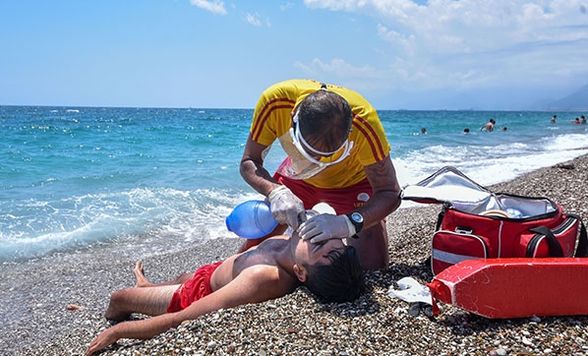Merhaba
Öncelikle acil durumlarda orada tesadüfen bulunan sağlık personeli veya ilk yardım bilen herhangi bir vatandaş istemediği sürece hiçbir riski almaya mecbur değildir.
Görevi başındaki sağlık personeli ise suni teneffüs gibi yakın temas gerektirecek müdahalelerde gerekli olan ekipmanları yanlarında taşırlar. Ağızdan ağıza temas olmadan da hastaya solunum desteği verilebilir. Görseldeki ambu, buna iyi bir örnek.

Sağlık personeli (örneğin olay yerine gelen ambulans) özellikle pandemi döneminde yanında solunum desteği için kullanılabilecek hiçbir cihaz bulundurmuyorsa yüksek ihtimalle hastaya ağızdan ağıza solunum desteği vermedikleri için değil, bahsi geçen cihazları yanlarında bulundurmadıkları için ceza alacaklardır. (kişisel bir fikir, net bir bilgim yok açıkçası)
Ancak görev başında olmayan ve gönüllü olarak hastaya yardım etmek isteyen sağlık personeli veya herhangi bir vatandaş için çeşitli öneriler yapan bazı yayınlar vardır.
“If casualties are suspected of having COVID-19, the updated American Heart Association (AHA) guidelines recommend lay rescuers should perform only chest compression and defibrillation in adults, and to carry out full CPR only in children who are at high risk of respiratory failure. The AHA recommends both the rescuer and the casualty should wear a surgical mask or face covering [6]. Visor eye protection is not recommended.
The Australian and New Zealand Committee on Resuscitation (ANZCOR) recommendations released on 3 April 2020 suggest that lay rescuers should only do chest compressions and public-access defibrillation. However, lay rescuers who are willing and highly skilled can provide rescue breathing to infants and children while adhering to standard precautions and safety procedures for handwashing, cleansing and decontamination [7]. The guidelines of the International Liaison Committee on Resuscitation (ILCOR), updated on 10 April 2020, recommend mouth-to-nose-and-mouth ventilation for children (<8 years) if the rescuer is sufficiently skilled and willing to accept the risk [5].
On 24 April 2020, the ERC published specific recommendations [8], which were then followed by national guidelines released by the UK and Italian Resuscitation Councils. The ERC guidelines set out a detailed CPR procedure for lay rescuers in the case of suspected or confirmed COVID-19 adults. Resuscitation is to be carried out by rescuers wearing filtering face masks (FFP2 or FFP3) and disposable gloves via chest compressions only and without performing breathing manoeuvres. The rescuer is to cover the nose and mouth of the victim with a surgical mask (or a strip of cloth), before performing chest compressions.
The ERC suggests treating every victim as if he/she were potentially infected by COVID-19. Therefore, if the casualty is responsive and able to provide self-care, the ERC suggests providing first-aid advice from a safe social distance (2 m). Appropriate PPE (i.e. gloves, FFP2 or FFP3 mask and visor eye protection) should be worn and the casualty should wear a surgical mask. The rescuer should call for specialist healthcare assistance and wear his/her own PPE. Direct assistance should be provided only if absolutely necessary (e.g. in case of haemorrhage, applying a dressing, use of an adrenaline auto-injector, assessing for responsiveness and positioning of a victim) in order to limit exposure.”
İşte onlar da bu şekilde, genellikle çok yakın olan ağızdan ağıza temastan kaçınacak şekilde müdahaleleri önermişlerdir. Umarım tatmin edici bir cevap olmuştur.
Kaynaklar
- ||. (2021). First Aid During The Covid-19 Pandemic. PMC. | Arşiv Bağlantısı
- ||. Cankurtaranlar Temas Ederek Suni Teneffüs Yapamayacak. (3 Nisan 2021). Alındığı Tarih: 3 Nisan 2021. Alındığı Yer: | Arşiv Bağlantısı

